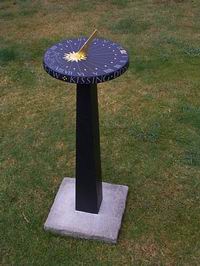 Down
Down
through the ages, many different styles of sundials developed and, until the seventeenth century, were the most common way of telling the time.
 Sundials work when the sun causes a shadow to fall correctly on a scale of hours marked on the dial.
We know that the sun appears to travel around the earth (360 degrees) once every
24 hours, so, radial lines drawn 15 degrees apart on a surface which is parallel to the
earth's equator can represent hours. This would be an equatorial dial.
The shadow is usually cast by a rod ( gnomon ) rising from the centre of the dial,
parallel to the earth's axis ie pointing towards the Pole Star.
Common horizontal garden sundials still have the gnomon pointing towards the Pole Star,
but the hour lines are not equally spaced.
Sundials work when the sun causes a shadow to fall correctly on a scale of hours marked on the dial.
We know that the sun appears to travel around the earth (360 degrees) once every
24 hours, so, radial lines drawn 15 degrees apart on a surface which is parallel to the
earth's equator can represent hours. This would be an equatorial dial.
The shadow is usually cast by a rod ( gnomon ) rising from the centre of the dial,
parallel to the earth's axis ie pointing towards the Pole Star.
Common horizontal garden sundials still have the gnomon pointing towards the Pole Star,
but the hour lines are not equally spaced.
 Each sundial is designed to work in a particular location and is calibrated for that
latitude and longitude.
The path of the shadow can be calculated for any given date, and so birthdays, anniversaries or other significant dates can be marked on these unique timepieces.
Each sundial is designed to work in a particular location and is calibrated for that
latitude and longitude.
The path of the shadow can be calculated for any given date, and so birthdays, anniversaries or other significant dates can be marked on these unique timepieces.
 On an
Analemmatic Sundial,
where the shadow is to be cast by an upright person,
the hour points have to lie along an ellipse and the human gnomon also has to move along a
centre line each month throughout the year. At noon, the shadow will be cast due north.
The points on the ellipse have to be correctly positioned for the latitude and longitude of that dial.
So each dial is designed for its unique location.
On an
Analemmatic Sundial,
where the shadow is to be cast by an upright person,
the hour points have to lie along an ellipse and the human gnomon also has to move along a
centre line each month throughout the year. At noon, the shadow will be cast due north.
The points on the ellipse have to be correctly positioned for the latitude and longitude of that dial.
So each dial is designed for its unique location.
